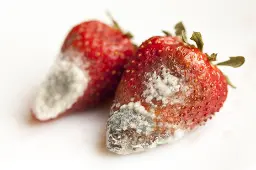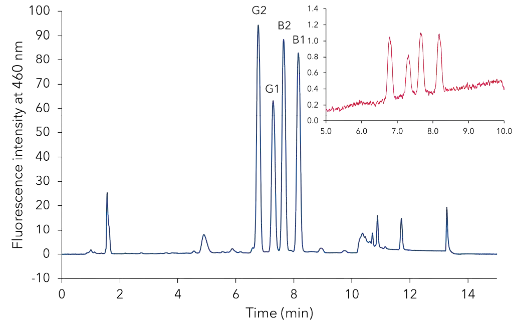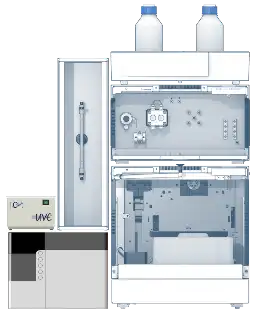
Science with Passion
Application No.: VFD0178 Version 1 12/2019
Quick and easy determination of aflatoxins in food matrices with photochemical post column derivatization
Kristin Folmert, Mareike Margraf, Kate Monks; applications@knauer.net
KNAUER Wissenschaftliche Geräte GmbH, Hegauer Weg 38, 14163 Berlin

Photo: Fotolia
Summary
One of the 10 most dangerous chemicals in the world is the aflatoxin B1. For both, humans and animals the consumption of the toxic aflatoxins can lead to serious health damage. They are produced by mold fungi on food and feed products. Herewith, a simple, robust and highly sensitive method for the analysis of aflatoxins in food and feed is provided to ensure consumer safety.
Introduction
Aflatoxins are the best known group of mycotoxins produced as secondary metabolites by fungi, mainly by Aspergillus flavus and Aspergillus parasiticus, but to a smaller extent also by other strains. [1] Aflatoxins can be produced on crops in the field or during storage of agricultural products, especially under warm conditions and high humidity. Aflatoxins also pose a significant economic burden, causing an estimated 25 % or more of the worlds food crops to be destroyed annually. [2] Unfortunately, these substances can persist long after the fungi have been killed and therewith contaminate foods. Most mycotoxins are stable compounds that are also not destroyed during food processing or cooking. Although a large number of aflatoxins exist only a limited number is important in analytical practice. Aflatoxin B1 is most widespread and can be found in food and feed products such as peanuts, pistachios, corn and cottonseed, dried fruits, and all processed products. It is highly toxic and the WHO classified it as a group 1 carcinogen. [2] The aflatoxins B2, G1, and G2 are usually found accompanying B1 in lower concentrations in the contaminated samples (Fig. 1). Governmental institutions and health protection agencies like FDA, WHO and European Commission apply these methods on a large scale to control marketed food products and animal feed. [2, 3, 4] Additionally, the presence of aflatoxins B1, B2, G1, and G2 in a variety of processed and unprocessed foods is controlled in countries around the world. 0.1 µg/kg processed cereal-based foods and all kinds of dietary foods for special medical purpose, both for babies, infants and young children is the lowest maximum aflatoxin level set by the European Commission according to regulation EG 1881/2006. [5] The required verification method is HPLC with fluorescence detection and preliminary sample extraction described in the KNAUER application notes VFD0179-VFD0182. Unfortunately, Aflatoxins B1 and G1 show only minimal fluorescence and are thus difficult to detect. Irradiating the aflatoxin mixture with UV light of 254 nm, the aflatoxins B1 and G1 undergo photo-induced hydroxylation and can then be measured through fluorescence spectrometry more sensitively.
Results
For the method development of an universally usable aflatoxin HPLC method an equal mixture of food extracts was produced. The mixture contained extracts from different nuts, dried fruits, and cereal baby food products. Nuts are the most often affected source of aflatoxins, while dried fruits are the most difficult matrix for the analysis. Cereal puree and rusk for babies are prominent examples for the food group with lowest accepted action levels defined by the European Commission. The resulting gradient method takes 9 minutes followed by a 6 minute long column cleaning and equilibration step (Fig. 2). The resulting peak resolution for the aflatoxin peaks was higher than 1.5 and all matrix peaks could be separated. The determined limits of detection (LOD) were 0.05 ng/mL for aflatoxins B1/G1 and 0.015 ng/mL for B2/G2 (Fig. 3). These values are 3.4 and 11.3 times lower than requested by the European Commission [5]. To evaluate the quality of the developed method, the recovery (W), the standard deviation (RSD), and the robustness were established. The recovery ratios were determined with three repetitions at three concentration levels. The used limits were the limit of qualification (LOQ), twice the LOQ and 20 ng/mL. The results in Tab. 1 are an average of the three concentration limits. At the high level the recovery was around 100 % with decreasing quality for the very low concentrations, which is reasonable due to the volume of the derivatization reaction coil. For the standard deviation 8 identical repetitions with 1 ng/mL of an aflatoxine standard mixture were measured (Tab. 2). The RSD was lower 0.1 % for the retention times and lower 0.5 % for the peak area and height. For robustness evaluation a variation of the method parameters was performed (Tab. 3). The method was assumed to be robust if all matrix peaks and the four aflatoxin peaks were baseline separated from each other. The developed aflatoxin method resulted to be very robust against changes in temperature, flow rate and the eluent mixture during the gradient.

Fig. 1 Chemical structures of the four aflatoxins and the reaction mechanism of the photochemical activation

Fig. 2 Chromatogram of a mixture including equal parts of extraction products from peanuts, pistachios, cereal puree and rusk for babies and dried fruits (cherries, cranberries, raisins, aronia, and plums) spiked with 20 ng/mL of the aflatoxins B1/G1 and 6 ng/mL B2/G2 (blue). Zoom into a chromatogram of a standard mixture of the four aflatoxins at the LOQ (red).

Fig. 3 Concentration curves for the four aflatoxins with correlation coefficient. The empiric determined LOD for the aflatoxins B1/G1 was 0.05 ng/mL and for B2/G2 0.015 ng/mL.

Fig. 4 Example of three chromatograms with 1.0 ng/mL aflatoxin B1/G1 and 0.3 ng/mL B2/G2 measured for robustness validation. The method was robust if the two labeled matrix peaks were baseline separated from the aflatoxin peaks.
Materials & Methods
The dedicated AZURA® Aflatoxin system consisted of a low pressure gradient AZURA P 6.1L pump, an AZURA autosampler AS 6.1L, an AZURA CT 2.1 column thermostat, and an RF-20A fluorescence detector with coupled photochemical post column derivatization module. The photochemical post column derivatization enables a non-toxic and fast derivatization at room temperature. In comparison to previous methods, using saturated iodine reaction coils or with electrochemical generated bromine in a KOBRA cell, no toxic halogenic reagents were used for derivatization. Thus, no halogenic solvent waste was produced. The column was a temperature and mechanical robust Eurospher II C18 100-3 column. The sample preparation was performed with liquid-liquid and solid phase extraction as described in the KNAUER application notes VFD0179, VFD0180, VFD0181, and VFD0182.
Discussion
Using the UVE photochemical reactor for post column derivatization in combination with the AZURA Analytical HPLC system and Eurospher II C18 column, it was possible to detect the four aflatoxins B1, B2, G1 and G2 in one chromatographic run with the very low LOD of 0.05 ng/mL for B1/G1 and 0.15 ng/mL for B2/G2. The high robustness and reproducibility of the method were confirmed by empirical quality control. Furthermore, the handling of the photochemical reactor was very easy because no further chemicals were required for derivatization.
References
[1] M.T. Hedayati, A.C. Pasqualotto, P. Bowyer, D.W. Denning, Microbiology 2007 (153) 6, 1677-1692. doi: 10.1099/mic.0.2007/007641-0
[2] World Health Organization, Food Safety Digest - Aflatoxins, Department of Food Safety and Zoonoses 2018, Ref. No.: WHO/NHM/FOS/RAM/18.1.
[3] U.S. Department of Health and Human Services, Food and Drug Administration, Sec.683.100 Action Levels for Aflatoxins in Animal Food 2019.
[4] Die Europäische Gemeinschaft, Verordnung (EG) Nr. 401/2006 Der Kommission - Zur Festlegung der Probennahmeverfahren und Analysemethoden für die amtliche Kontrolle des Mykotoxingehalts von Lebensmitteln 2016.
[5] The European Commission, Commission Regulation (EC) No 1881/2006 of 19 December 2016 - Setting maximum levels for certain contaminants in foodstuffs, Official Journal of the European Union, 2006, L 364/5 - L 364/24.
Additional Results
Tab. A1 Averaged recovery ratios measured at LOQ, twice LOQ and 20 ng/mL aflatoxin
Aflatoxin | W (%) |
B1 | 80 ± 6 |
B2 | 78 ± 5 |
G1 | 87 ± 7 |
G2 | 84 ± 6 |
Tab. A2 Standard deviation (RSD) of 8 repetitions at the same conditions
Parameter | RSD (%) |
Retention time | < 0.1 |
Peak area | < 0.5 |
Peak height | <0.5 |
Tab. A3 Robustness of the method
Parameter | Robust range |
Temperature | ± 2°C |
Flow rate | ± 0.2 mL/min |
tG ACN | ± 2% |
tG MeOH | ± 2% |
tG H2O | ± 2% |
Additional Materials and Methods
Tab. A4 Instrument setup
Column temperature | 60°C | Time constant | 0.1 s |
Injection volume | 10 µL | Excitation | 365 nm |
Injection mode | Full Loop | Emission | 460 nm |
Detection | FLD | Post column derivatization | 254 nm |
Data rate | 50 Hz | Flow rate | 2.4 mL/min |
Tab. A5 Pump program
Time (min) | Water (%) | ACN (%) | MeOH (%) |
0 | 83.0 | 5.0 | 12.0 |
0.5 | 83.0 | 5.0 | 12.0 |
9.0 | 54.0 | 34.0 | 12.0 |
9.1 | 0.0 | 100.0 | 0 |
12.0 | 0.0 | 100.0 | 0 |
12.1 | 83.0 | 5.0 | 12.0 |
15.0 | 83.0 | 5.0 | 12.0 |
Tab. A6 System configuration
Instrument | Description | Article No. |
Pump | AZURA P6.1L, LPG | |
Autosampler | AZURA AS 6.1L | |
Fluorescence detector | RF-20A | |
Thermostat | AZURA CT 2.1 | |
Column | Eurospher II C18 100-3 150-4.6 mm | |
Post column derivatization | UVE Box, 50 Hz | |
Interface box | IFU 2.1 Lan | |
Software | ClarityChrom 8.1 |
Related Applications
VFD0179 - Determination of Aflatoxines in Peanut Samples - From Extraction to High Efficient Detection
VFD0180 - Determination of Aflatoxines in Pistachio Samples - From Extraction to High Efficient Detection
VFD0181 - Determination of Aflatoxines in Dried Fruit Samples - From Extraction to High Efficient Detection
VFD0182 - Determination of Aflatoxines in Cereal Baby Food Samples - From Extraction to High Efficient Detection
Application details
|
Method |
HPLC |
|
Sample |
Aflatoxin B1, B2, G1 and G2 |
Separation column | Eurospher II C18 100-3 150-4.6 mm |
Stationary phase | RP |
Separation conditions | |
Mode | RP |
|
Version |
Application No.: VFD0178 | Version 1 12/2019 | ©KNAUER Wissenschaftliche Geräte GmbH |



